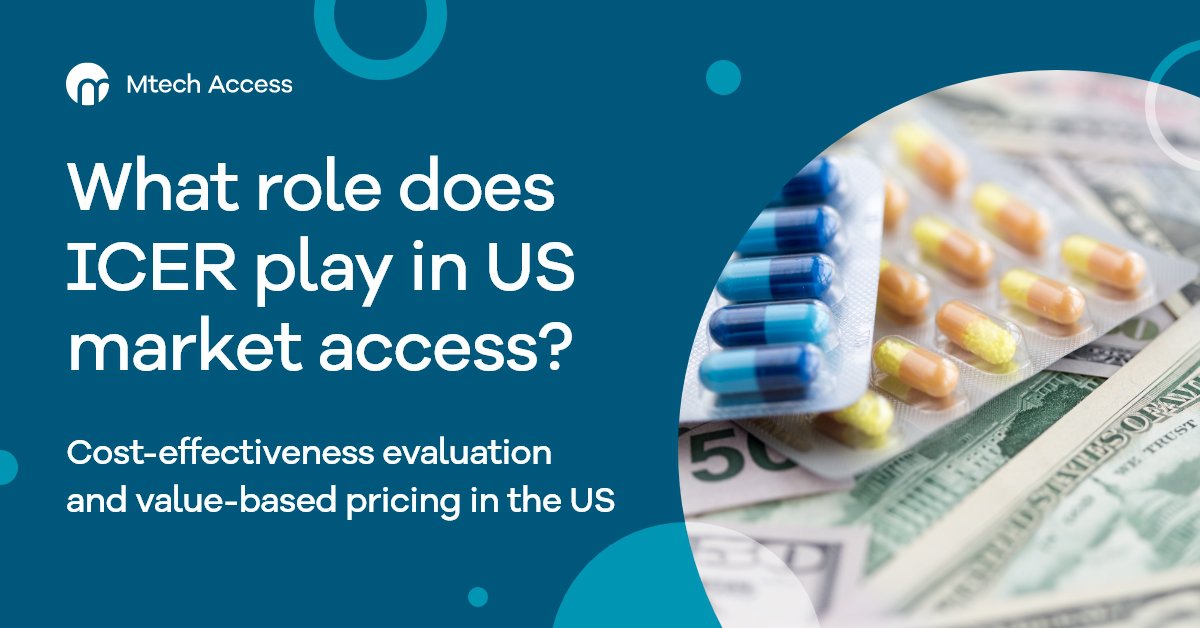
The Institute for Clinical and Economic Review (ICER) is becoming an increasingly important player in US market access. As more transformative, but costly, treatments come to market, payers must continue to keep an eye on their expenditure in a challenging economic climate.
ICER has a key role in evaluating and communicating the value of medicines to US stakeholders, to help them make informed decisions regarding budget, coverage, and resource allocation, while ensuring patients have access to innovative treatments.
In this article, we delve into ICER’s mission and its influence on drug pricing and access in the US. We also explore the importance of maximising engagement with ICER for favourable pricing and access outcomes.
Jump to:
- What is ICER?
- How does ICER conduct its evidence reviews?
- ICER’s ‘Unsupported Price Increases’ reports
- ICER’s impact on drug pricing and access
- Why should industry engage with ICER?
- 4 top tips for maximising engagement with ICER
- A suite of resources to support your conversations
What is ICER?
Founded in 2006, ICER is an independent, nonprofit research organisation, which evaluates the clinical and economic value of healthcare interventions (1).
ICER’s primary function is to conduct comprehensive evidence reviews of new pharmaceutical innovations that are likely to have an impact on the US healthcare system. ICER produces reports that evaluate the clinical efficacy, safety, and cost effectiveness of an intervention (or interventions for the same indication).
These reports are not dissimilar to those produced by European health technology assessment (HTA) agencies, such as NICE in England. Following ICER’s recommendations is not mandated within the US, however, this is the case with guidance produced by NICE and HTA bodies in other markets.
ICER’s influence on payer decision-making, price negotiations, and coverage decisions is understood to be growing. Payers, policymakers, and healthcare providers can use ICER’s reports to make informed choices regarding coverage and resource allocation for evaluated products.
Perhaps most importantly, ICER estimates a value-based price (VBP) via cost-effectiveness modelling, which serves as a reference point for Pharma companies, payers, and policymakers, with regard to pricing and reimbursement decisions.
How does ICER conduct its evidence reviews?
The first step is topic selection by surveying the drug research and development (R&D) pipeline. Priority is given to products and indications that will likely significantly impact the healthcare landscape, due to improved outcomes, financial implications, reduced health inequalities, or better alignment with healthcare reform initiatives (2).
Once a topic is selected, ICER notifies stakeholders and conducts a scoping phase to understand the disease and treatments. A draft evidence report is produced with epidemiological, clinical, and cost-effectiveness data. After public commentary, the report is updated and a public meeting is held before the final report is published. Information from the entire process is made publicly available to inform subsequent policy and decision-making.
ICER’s ‘Unsupported Price Increases’ reports
In addition to its evidence reviews, ICER publishes annual ‘Unsupported Price Increases’ reports. These highlight potential instances of excess healthcare spending, where ICER deems that product price increases are not supported by evidence of new clinical benefit. ICER’s Chief Medical Officer recently stated that price increases have slowed since they began publishing the reports, indicating its increasing influence in this area.
ICER’s impact on drug pricing and access
Although following ICER’s recommendations is not mandated, its influence on payer decision-making, price negotiations, and coverage decisions is understood to be growing.
There are notable examples of ICER reports being directly linked to:
- Negotiation of discounts
- Applications for additional requirements
- Restrictions for treatments deemed not cost effective
In 2018, CVS Caremark, one of the largest pharmacy benefit managers in the US, shifted to a value-based drug pricing strategy informed by ICER. Under this strategy, drugs surpassing the cost per quality-adjusted life year (QALY) threshold of $100,000 would be excluded from drug plans to help reduce costs for patients (3).
A recent survey found that, between 2020 and 2022, 79% of US payers were at least occasionally (59%) or often (20%) influenced by ICER’s recommendations for coverage decisions (4). The survey also found that there was a balance between using their recommendations to expand or to restrict coverage. Furthermore, their recommendations were used for contracting discussions, defining prior authorisation criteria, and validating supportive coverage decisions (4).
The passing of the Inflation Reduction Act (IRA) has put drug spending in the US firmly in the spotlight. Under the IRA, the top 10 drugs that have contributed most to government expenditure will have their prices renegotiated in 2026. Researchers are beginning to explore the potential benefits of the US adopting VBP more widely. One study found that if all drugs assessed by ICER since 2015 were priced in accordance with ICER’s estimated VBP at $100,000 per QALY, this could equate to annual savings of $11.8 billion (5).
Given ICER’s increasing influence, the benefit of proactive engagement with them as an important stakeholder in US market access should not be underestimated.
Why should industry engage with ICER?
Engaging with ICER could help companies better understand how their product’s value proposition will be received in the US healthcare market. By taking on board ICER’s evaluations and recommendations, companies can refine their value messaging, pricing strategies, and market access initiatives, to ultimately enhance their competitive positioning and market success.
In a recent interview, ICER’s President highlighted how ICER tends to reach out to companies before publishing a report, to:
- Explore their evidence further
- Request evidence that isn’t in the public domain
- Discuss limitations of the evidence
- Ask about the company’s own efforts and economic modelling
This informs ICER’s assessment approach.
Companies may also approach ICER for information on pricing before launch. ICER welcomes this open discussion and is keen to foster engagement that drives a mutually beneficial relationship with manufacturers. Pharmaceutical companies may gain an understanding of the pricing outcome earlier than if they weren’t engaged with ICER. This can enable them to prepare for negotiations given the eventuality of a price reduction compared with the list price.
So, should you engage with ICER? This will partly depend on the price that you have in mind and whether it’s likely to align with ICER’s VBP. Generally, it is probably better to engage with ICER than not. Mtech Access can support you with this process, with a focus on successful negotiation.
4 top tips for maximising engagement with ICER
There are multiple touchpoints in ICER’s review process for manufacturers to engage and influence. Research has suggested potential associations between manufacturer engagement and improved cost-effectiveness ratios. Here are some of our tips for getting the most out of your engagement with ICER:
1) Be prepared
ICER notifies manufacturers of an upcoming report topic that may affect them 5 weeks before it is publicly announced. Manufacturers can get ahead earlier than this, however, if they anticipate that their asset is likely to fulfil ICER’s topic selection criteria and will soon be undergoing Food and Drug Administration (FDA) review. Having a strategy in place and a suite of resources in development for the eventuality of topic selection will make engagement with ICER more efficient and productive.
2) Provide feedback
ICER welcomes critique and feedback from manufacturers at multiple stages throughout report and economic model development. Research has found that manufacturers can improve their chances of influencing ICER’s findings by submitting comments that are clear and actionable, and offering specific alternatives to their approach (6). Research also indicates that ICER is more likely to make changes to its base case analysis when these can be justified by comments citing alternative data or published articles.
3) Consider analogue review
Manufacturers may be able to optimise their engagement strategies with ICER by looking at previous reviews in analogous disease areas. ICER publishes all resources from every stage of report development publicly. This provides a wealth of information on what ICER perceives to be the strengths and limitations of the product, giving manufacturers insight into the potential outcome of the review and how they can tailor engagements and strategies accordingly.
4) Get up to speed with methods of cost-effectiveness analysis
Cost-effectiveness analysis of interventions is not widely applied in the US and may be new to many market access and commercialisation teams. Given the importance of critiquing and providing feedback on ICER’s proposed economic models, it is crucial for manufacturers to understand cost-effectiveness evaluation techniques. An external agency, like Mtech Access, may be best placed to help you get up to speed. (Our expert Health Economists even offer training courses in cost-effectiveness evaluation!).
A suite of resources to support your conversations
ICER works in accordance with strict timelines, thus manufacturers may only have a few weeks to assimilate and share data. Early preparation of a suite of resources to support engagement will streamline and accelerate this process.
The following information and materials are likely to be useful to, or directly requested by, ICER during the report development process (7):
- Key publications of patient-relevant and patient-centred outcomes, especially those not adequately captured in clinical trial data
- Key research needs and contextual considerations, which can be identified through scoping and literature reviews
- Stakeholder mapping and key informant recommendations (e.g. principal investigators from clinical trials, members of internal clinical and health economics and outcomes research [HEOR] teams, and national or regional clinical experts)
- Budget impact assessments to identify services that could be cut back to release additional budget for higher cost services and innovations
- Information about manufacturing, research, and/or development costs that are important factors in justifying the prices of products, particularly for ultra-rare conditions
- Key data inputs for economic evaluation, including health state utilities, detailed safety findings, information on prior and/or subsequent treatments received, and selected tertiary outcomes (e.g. productivity)
- Estimates of product uptake and pricing
For help sourcing and developing the above information and resources, reach out to our experts today at info@mtechaccess.co.uk.
Explore ICER’s influence with us at ISPOR
ICER plays a critical role in evaluating drug value. Its impact on pricing and access is growing in the increasingly budget-focused US healthcare system.
Understanding ICER’s influence and how to maximise opportunities for engagement enables manufacturers to align product development with payer expectations, optimise pricing strategies, and enhance patient access to new therapies.
Optimal engagement with ICER can contribute to favourable outcomes. It does, however, require Pharma companies to deploy significant resource and organisation. Our experts can help you:
- Develop your pricing strategy
- Establish an understanding of cost effectiveness and VBP
- Source the necessary information and evidence
- Develop the resources you need
- Engage with ICER’s process
Email info@mtechaccess.co.uk to speak to our experts about the value of engaging with ICER as part of your US and wider global market access and commercialisation strategy.
References and further reading:
- Institute for Clinical and Economic Review. Independent Funding. Available from: https://icer.org/who-we-are/independent-funding/. Accessed on: 26th March 2024.
- Institute for Clinical and Economic Review. Topic Selection. Available from: https://icer.org/our-approach/methods-process/value-assessment-framework/topic-selection/. Accessed on: 26th March 2024.
- First Report: Managed Care. CVS Shifts to ICER Value-Based Drug Pricing Strategy. 2018. Available from: https://www.hmpgloballearningnetwork.com/site/frmc/article/cvs-shifts-icer-value-based-drug-pricing-strategy. Accessed on: 26th March 2024.
- Zheng C, et al. Impact of ICER Assessments on Payer Decision Making in the United States. Value in Health. 2023;26(4):S268.
- Yeung K, et al. Value-Based Pricing of US Prescription Drugs: Estimated Savings Using Reports From the Institute for Clinical and Economic Review. JAMA Health Forum. 2022; 3(12):e224631.
- Breslau RM, et al. Should Drug Companies Engage with ICER? An Empirical Analysis of How Often Manufacturers Engage with ICER and Whether Engagement May Influence ICER’s Cost‑Effectiveness Estimates. Pharmacoecon Open. 2022;6(6):893-895.
- Institute for Clinical and Economic Review. Manufacturer Engagement. Available from: https://icer.org/our-approach/methods-process/manufacturer-engagement/. Accessed on: 26th March 2024.


